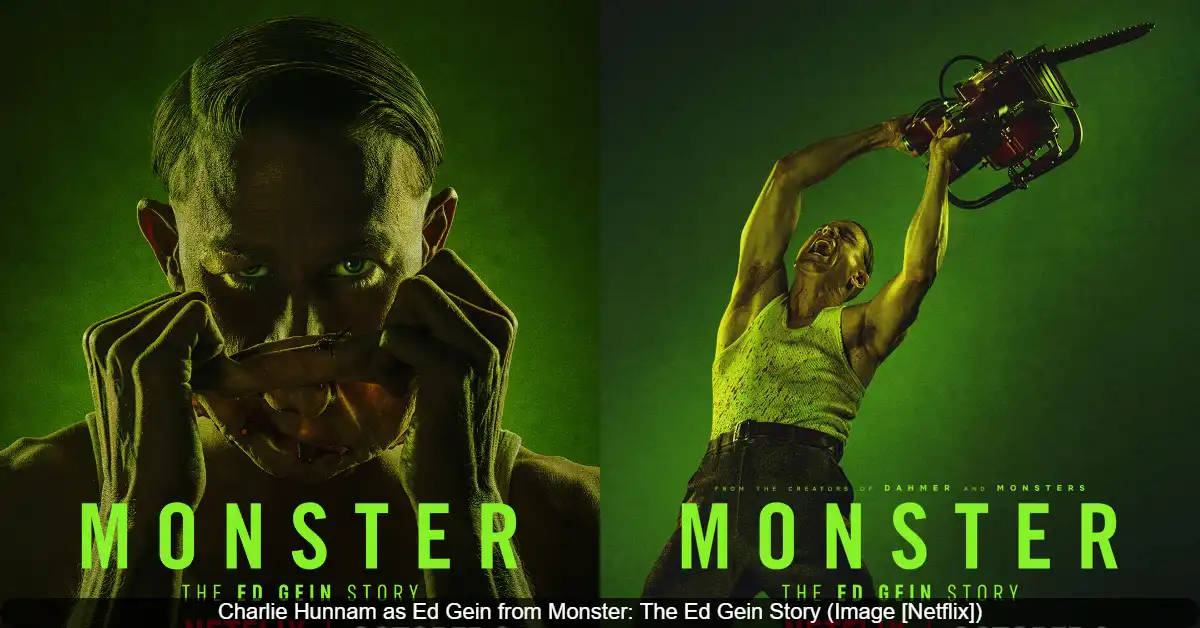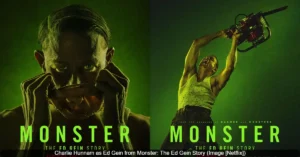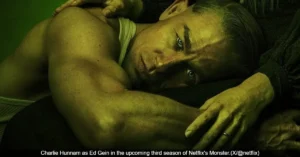The new Netflix series Monster: The Ed Gein Story connects the infamous “Butcher of Plainfield” with other notorious criminals, including mass murderer Richard Speck. While the show creates a dramatic narrative where Speck idolizes Gein, this specific connection is a fictional addition for television, with no historical evidence supporting that the real Richard Speck was inspired by Ed Gein.
The Story Behind the Netflix Series
Monster: The Ed Gein Story is the third installment in co-creator Ryan Murphy’s true-crime anthology series. It stars Charlie Hunnam as Ed Gein, the Wisconsin serial killer whose gruesome crimes in the 1950s became the unlikely inspiration for classic horror villains like Norman Bates in Psycho and Leatherface in The Texas Chain Saw Massacre.
The series explores Gein’s life, focusing on his intensely abusive relationship with his mother, Augusta, played by Laurie Metcalf. After her death, Gein’s mental state deteriorated, leading to murders and grave robbings. The show presents a version of his story that blends facts with fictionalized elements to explore his psyche and his lasting impact on popular culture.
Richard Speck’s Appearance in the Show
In the series’ eighth episode, titled “Godfather,” Richard Speck makes a brief appearance. The show depicts a fictional scenario where Speck, from prison, writes a letter to Ed Gein. In the letter, Speck thanks Gein for being his “role model” and includes disturbing photographs.
This narrative device is used to suggest a lineage of violence, where one killer inspires another. However, this is a creative liberty taken by the show’s writers. There are no historical records, letters, or statements from the real Richard Speck that indicate he knew of Ed Gein, wrote to him, or was influenced by his crimes.
Who Was the Real Richard Speck?
Richard Speck was a mass murderer responsible for one of the most shocking crimes in American history. On the night of July 13, 1966, he broke into a townhouse in Chicago that was home to student nurses. Over several hours, he systematically tortured and killed eight of the women. A ninth potential victim, Corazon Amurao, survived by hiding beneath a bed, and her testimony later helped identify and convict Speck.
Speck’s childhood was marked by difficulty. His father died when he was six, and his mother later married an abusive alcoholic. He struggled in school, dropped out at 16, and had a long history of arrests for crimes like trespassing, burglary, and assault before committing the mass murder. He was convicted in 1967 and initially sentenced to death, which was later commuted to a 400 to 1,200-year prison term. He died of a heart attack in prison in 1991.
The Real Ed Gein and His Legacy
Unlike Richard Speck, Ed Gein was not a prolific serial killer. He was officially convicted of killing two women: tavern owner Mary Hogan in 1954 and hardware store owner Bernice Worden in 1957. What made his case uniquely horrifying was what police discovered at his farmhouse—a collection of grotesque artifacts crafted from human remains. These included a suit made of human skin, skulls used as bowls, a belt made of nipples, and masks made from the faces of his victims.
Gein was diagnosed with schizophrenia and found not guilty by reason of insanity. He spent the rest of his life in psychiatric hospitals until his death in 1984. His story has been a source of public fascination for decades, primarily because of its influence on fiction. As one criminology professor noted, Gein’s case is unique because “it had the whole smorgasbord” of bizarre and terrifying elements.
Separating Fact from Fiction in ‘Monster’
Ryan Murphy’s productions are known for their dramatic storytelling, and Monster: The Ed Gein Story is no exception. The series justifies its fictionalized elements by focusing on Gein’s unstable mental state, suggesting that some scenes represent his distorted perceptions rather than historical fact.
The inclusion of Richard Speck is one of these fictionalized elements. The show uses it to explore a theme of how notorious criminals can become twisted icons for others. As one analysis of the series points out, the show is interested in “how truth becomes legend, and vice versa.”
For those interested in a more factual portrayal of Richard Speck, he is featured in the Netflix series Mindhunter, which takes a more documentary-like approach to its exploration of serial killers and the FBI agents who interviewed them.
Also Read: The Truth About Ed Gein’s Father: How George Gein’s Death Shaped a Killer











